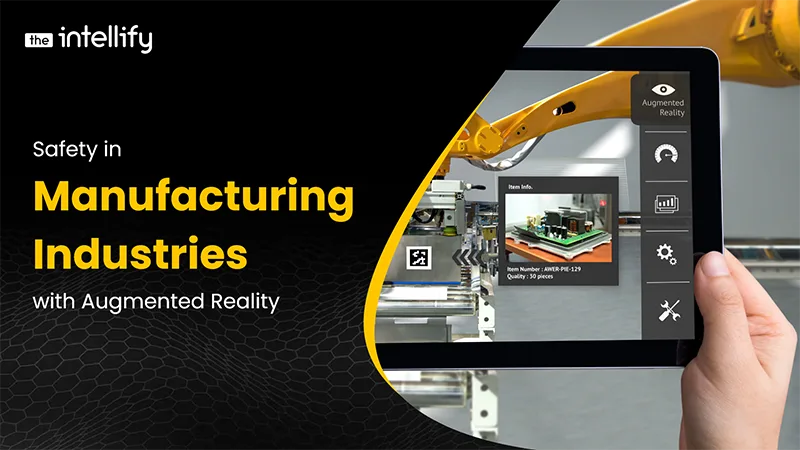
Ensuring safety and reducing the risk of accidents within industrial premises is a serious concern for companies and organizations in the manufacturing, construction, and other heavy production industries. These industries often involve complex and potentially hazardous operations, and the risk of accidents and injuries is always at stake. Accidents and injuries can not only have serious consequences for workers but also impact productivity and profitability for businesses.
Implementing effective strategies and measures to enhance safety and reduce the risk of accidents in industrial settings is essential. Gone are the days when a single person could be posted to supervise the Industry and keep Operations running smoothly. With time, Industries and Sectors, too, need to adopt easy and more effective ways to sustain safety measures for production and staff.
Augmented Reality has the potential to provide a solution here by providing workers with real-time information and guidance. In this blog post, we want to highlight some of the main features that can improve the safety measures of your manufacturing units!
Steps to be considered while maintaining safety measures in Industries:
- Augmented Reality can be used to display data on the performance of safety equipment, such as personal protective equipment or emergency shutdown systems, to make it easier for individuals/workers within the production and manufacturing units to understand.
- AR Solutions helps workers identify and address potential problems before they become hazardous or life-threatening.
- AR can also highlight potential hazards or danger zones, alerting workers to take extra caution.
- Augmented Reality Solutions cleverly includes the precaution to ensure company safety by promptly addressing possible risks.
- The workforce here reacts in time to avoid potential damage.
With the help of Augmented Reality Solutions, such humongous challenges within the Manufacturing and Production Units can also be solved easily. With a mix of digital workflows and remote assistance, Team The Intellify is here to create and develop just the right AR Solution for your Industrial Unit.
We look forward to helping you identify your businesses and brands’ most valuable use cases.

Written By, Jalaj Shah
The COO and Co-Founder of The Intellify. Jalaj enjoys experimenting with new strategies. His posts are fantastic for businesses seeking innovative development ideas. Discover practical insights from his engaging content.
Ready to Build Your Own Web App?
Get a Quote Now

Real Estate Mobile App Development 101: All You Need to Know
Today, the real estate industry is improving with the help of new technology. Mobile applications are one of the major aspects of this shift. Real estate mobile app development has become crucial for such businesses, which must remain relevant. The applications benefit buyers, sellers, agents, and property managers. In the contemporary world, individuals desire convenience […]


Top Mobile App Development Company In Switzerland
In Switzerland, there are lots of companies that can build mobile apps. Finding the right company for your project can be tricky. You want a dependable, affordable company that can get the job done on time. The Swiss software development industry is on the rise! It’s expected to grow from $8.17 billion in 2024 to […]


The Intellify Recognized as a Clutch Global Leader for Spring 2024
The Intellify has been named a top B2B company for AR, VR, Mobile, and Web Development services Ahmedabad, Gujarat, India — The Intellify, Innovating App Development Company, today announced its recognition as a 2024 Spring Global Award winner for AR, VR, Mobile, And Web Application Development services on Clutch, the leading global marketplace of B2B service […]


Real Estate Mobile App Development 101: All You Need to Know
Today, the real estate industry is improving with the help of new technology. Mobile applications are one of the major aspects of this shift. Real estate mobile app development has become crucial for such businesses, which must remain relevant. The applications benefit buyers, sellers, agents, and property managers. In the contemporary world, individuals desire convenience […]


Top Mobile App Development Company In Switzerland
In Switzerland, there are lots of companies that can build mobile apps. Finding the right company for your project can be tricky. You want a dependable, affordable company that can get the job done on time. The Swiss software development industry is on the rise! It’s expected to grow from $8.17 billion in 2024 to […]


The Intellify Recognized as a Clutch Global Leader for Spring 2024
The Intellify has been named a top B2B company for AR, VR, Mobile, and Web Development services Ahmedabad, Gujarat, India — The Intellify, Innovating App Development Company, today announced its recognition as a 2024 Spring Global Award winner for AR, VR, Mobile, And Web Application Development services on Clutch, the leading global marketplace of B2B service […]

0
+0
+0
+0
+
Committed Delivery Leads To Client Satisfaction
Client Testimonials that keep our expert's spirits highly motivated to deliver extraordinary solutions.

Let’s start a Conversation about your Business Goals!
Drop us a line to Start a Project with us
Contacts For Business
Contacts For Career












